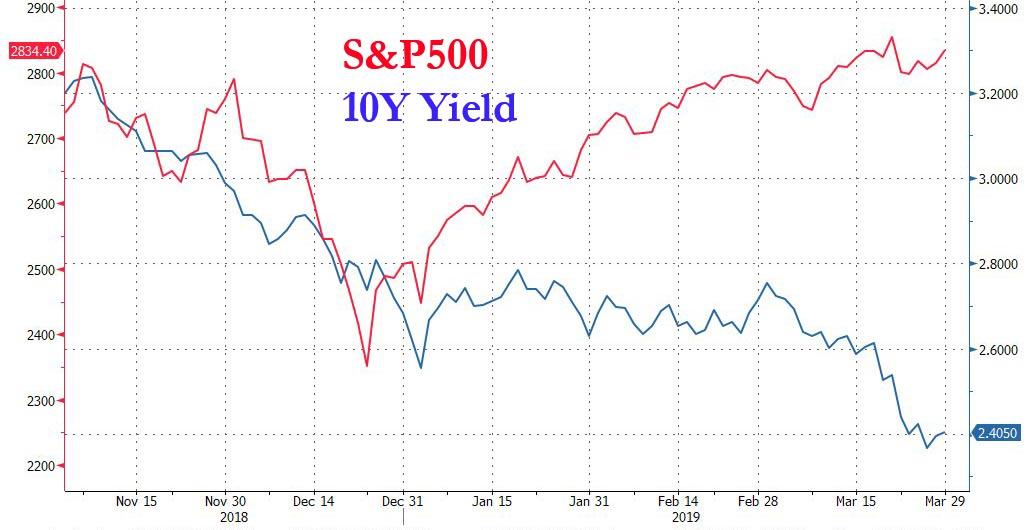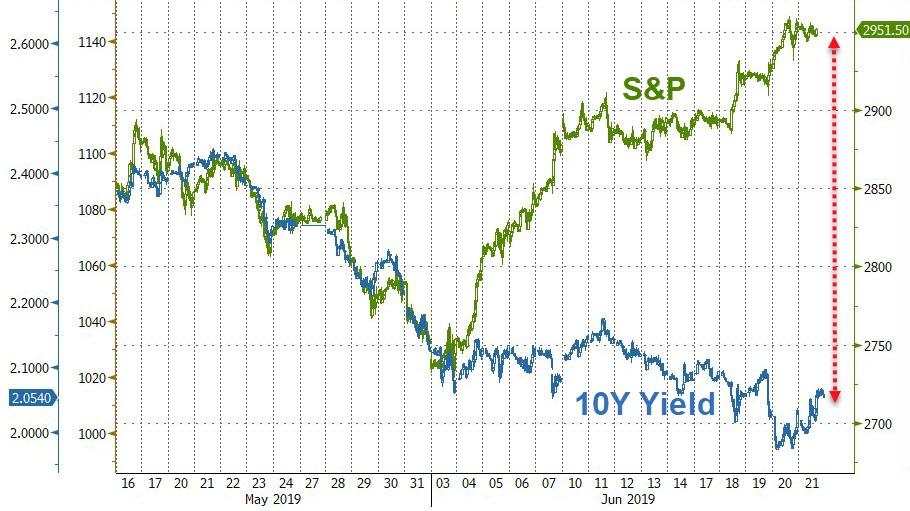At the end of March, we reported that the biggest concern for Goldman's clients was the gaping "market jaws", where stocks have moved sharply higher while yields have tumbled to multi-year lows, sparking investor confusion: is the bond market right in anticipating a period of acute deflation and/or recession, or is it wrong and stocks, which are less than 5% below their all-time highs, correct in their optimistic outlook.

As Goldman's David Kostin wrote, it was this decoupling that was dominating client discussions:
Ten-year US Treasury yields have plunged to 2.4%. From an investor perspective, stable equity prices coupled with falling interest rates means a wider earnings yield gap and implies a more attractive relative value for stocks assuming the economy does not fall into recession.
And, as Kostin recounted, one client told the chief Goldman equity strategist, that it all really "depends from which direction the jaws close – through higher rates or via lower equity prices."
In the three months since, the market's "alligator jaws" have gaped even wider, with the latest thrust coming first after Powell's early June admission that an easing cycle is imminent, following by last week's even more dovish FOMC announcement, which confirmed that a July rate cut is in the books, and sent stocks to new all time highs, while bond yields tumbled below 2%, the lowest in three years.

The problem with the above is that the confusion first expressed by Goldman's clients in March has not only gone away, but has become even more acute.
One attempt to explain this divergence - which is not really that surprising since it is merely an expected market reaction to an activist Fed which may soon buy bonds as QE resumes, sending stocks even higher - comes from Deutsche Bank's Aleksandar Kocic, who describes the above state as "economic entanglement", and using a somewhat loose analogy involving Schrodinger's paradox to explain the market reaction, illustrates "the current dimension of uncertainty", by imagining a situation "where we are alerted by a sudden crashing noise coming from our kitchen cabinet where our dining plates are stored."
What happened inside the cabinet -- the configuration of the plates -- is shown in the figure (for historical reasons this problem is referred to as Schrödinger plates). For the sake of argument, we assume that the cabinet doors are made of wood and we cannot see what is happening inside. Did the plates break or are they intact? If we open the door to check, the plates will fall out and break. If, on the other hand, we do not open the door, they might be intact, but we will never know. The plates are in a superposition of two states: broken and unbroken.

Does one really need quantum mechanics to explain what is a simple byproduct of central bank intervention perverting reflexive market return expectations across asset classes, one which Bloomberg explained far more succinctly in "Fed Loses Its Patience and Almost Everything You Can Trade Goes Nuts"? Well, since the author is Aleks Kocic, the financial equivalent of James Joyce and Jacques Lacan, the answer is yes. Here is what Kocic writes:
In the same way as Schrödinger plates, the economy at the moment is in a superposition of two states - it is both booming and it is headed for a recession. The two states of the economy are entangled. However, we cannot know which state we are in without interfering with it.
After reaching out to an actual quantum physicist with this explanation, we got the following response:
"There's no superposition at all. The plates are either broken or unbroken, there's absolutely no uncertainty about the physical state of those plates at any moment. The fact that one does not know because one cannot see without opening the cabinet means nothing about the state of the plates themselves because there is no physical superposition to collapse. It's amazing how confused people are about a basic quantum mechanical concept. But more staggering is why, if they don't understand it, they continue to insist to use it.
The economy is also not in any superposition. It also has a well defined state. My god."
Yet while we appreciate such purist anger at attempts at cross-disciplinary narrative pollution, Kocic does have a an interesting point: the jaws will continue to stretch as long as the Fed remains activist and perpetuates the economic instability which relies on the market's expectation that the Fed will step in at any moment to prevent a wholesale recession, to wit:
If the Fed does not cut rates (we open the door), the recession is likely.
If the Fed cuts rates, however (we do not open the door), the recession is averted, but we wouldn't know if the cuts were needed.
His conclusion: "in either case, Fed actions interfere with the state of the economy and affect the outcome, and in both cases we face the consequences." What is more troubling is that we have reached a point where the consequences of the Fed's actions are dire in either case, resulting in either recession or loss of Fed credibility and independence:
In the case of unresponsive Fed it is a recession, while in the case of an accommodative Fed it is the loss of central bank independence and potentially another round of trade wars and even more pressure on the Fed to cut rates with further markets addiction to stimulus and possibly higher inflation etc.
In not so many words, that is the ultimate Catch 22 that the Fed has created: the market and economy are only viable as long as the Fed is backstopping them; once the support goes away, the wave function - to extend the flawed analogy - of the economy and market collapses, and the true state of both is exposed (at the cost of trillion in risk asset losses).
We don't know when this market (or quantum) paradox will resolve itself; indeed, just a few days ago we asked precisely this question, wondering if Powell would finally resolve the "entangled" economic state, and break a few plates, on FOMC day:

Commenti
Posta un commento